Do you have a 5 gallon tank but not sure what fish will be the best choice?
You might be surprised, but there are many suitable fish for a 5 gallon tank!
These are considered nano tanks, but can have a big visual impact when properly stocked with the micro fish, or delicately aquascaped with aquatic plants.
I personally love building 5 gallon tanks and selecting the delicate, teeny tiny fish that look beautiful in this compact ecosystem.
It’s important to note, when keeping fish in such a small tank, you’ll need to stick to species that don’t grow very large, and the number of fish you own will be limited.
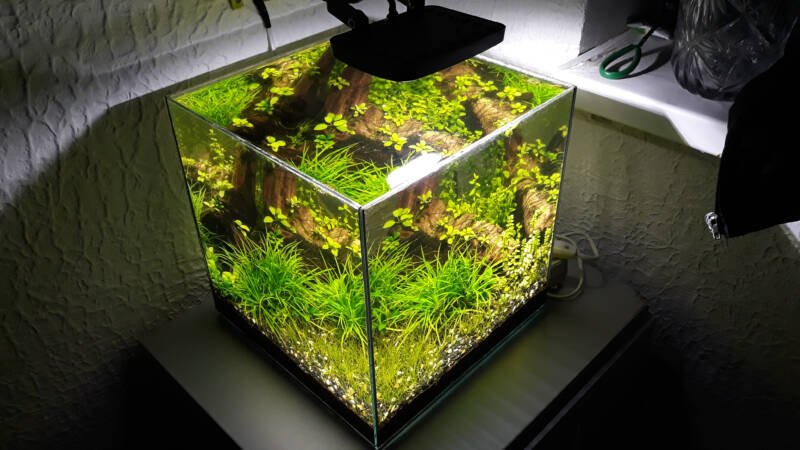
Shrimp and snails are an excellent choice for a 5 gallon tank, and more beginner friendly.
Before you decide to buy your 5 gallon tank, understand managing the water parameters in such a small tank will be more challenging.
You’ll likely need daily water changes, and is best for people with some aquarium experience as it can be demanding to maintain a tank that size and keep your fish healthy.
All the fish and shrimp listed here are suitable for a 5 gallon tank in the recommended quantity, but will thrive in a 10 gallon tank.
Here are some of my top recommended fish, shrimp, and vertebrates for 5 gallon FRESHWATER tanks.
1. Mosquito/Chili Rasbora (Borara brigittae)
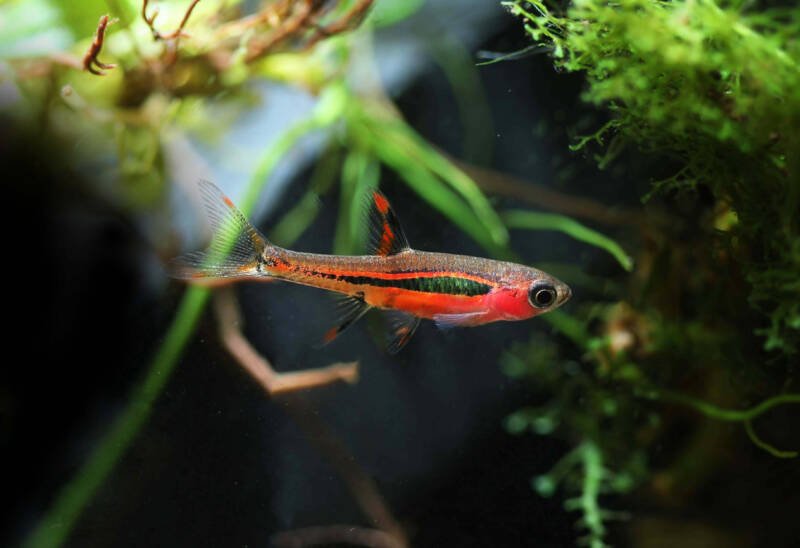
The Chili Rasbora is a bright, delightful fish from South West Borneo, Indonesia. They are some of the smallest fish in tropical freshwater aquariums and are relatively hardy.
These slender, ruby-red fish are best kept in a well-planted aquarium. They like having open water space to swim around and well-planted corners for hiding and resting. Good plants for your Chili Rasbora aquarium are Java fern, Straight Vals (vallisneria spiralis), Ancharis and Java Moss, which are great plants for low-light aquariums.
Keep Chili Rasbora in a school of six, though you can keep a larger school in bigger tanks. They are an active swimming species that likes space, so for a 5 gallon tank keep them as a single-species. They are sensitive to water conditions, so be on top of your tank care with regular water additions and testing. The API Masters Test Kit is our top choice for checking water parameters.
- Number: 4-5
- Size: 0.75 inches
- Difficulty: Intermediate
- Temperament: Peaceful
- Diet: Carnivorous—flakes, pellets, freeze dried food (micro size)
- Temperature: 68-82°F
2. Dwarf/Pygmy Rasbora (Boraras maculatus)
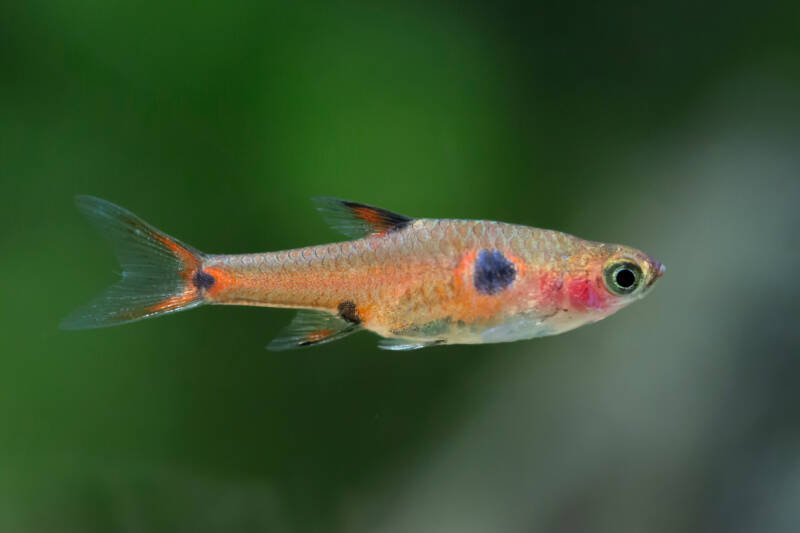
An active and sociable little fish from Asia that will do well in a small single-species tank. Sometimes called the Spotted Rasbora, this tiny fish has vivid red coloring and a large black spot on its body. Its hardiness makes it an excellent entry-level fish.
These rasboras are one of my favorites! I have had a school of four happily living in a planted tank for years. They buzz about every inch of the aquarium, exploring, eating and just swimming to swim.
I would say they are a touch on the shy side, so when the tank is approached they will dart behind a plant or driftwood, but then slowly peak around the corner to see if there are snacks.
They can be hard to source and a bit expensive as they are pretty delicate to transport. So ideally your local fish shop carries them so you can purchase confidently, and not have a sad DOA scenario.
They naturally are found in bogs, ponds, and streams and prefers slow-moving dark water.
Therefore, give them a tank with a dark substrate, a dark background is ideal, and an open central space for swimming. Plant the back and sides with tall growing plants like Straight Vals (vallisneria spiralis), to give them hiding spaces. Other suitable plant species are Java Moss, Ancharis, Hornwort and Guppy Grass, while floating plants will help prevent fish from leaping out of the tank, and offer additional hiding places in the roots. My favorite floating plants are water lettuce.
- Number: 5
- Size: 0.5-1 inches
- Difficulty: Beginner-Intermediate
- Temperament: Peaceful
- Diet: Carnivorous—flakes, pellets, freeze dried food (micro size)
- Temperature: 75.2-78.8°F
3. Strawberry Rasbora (Boraras naevus)
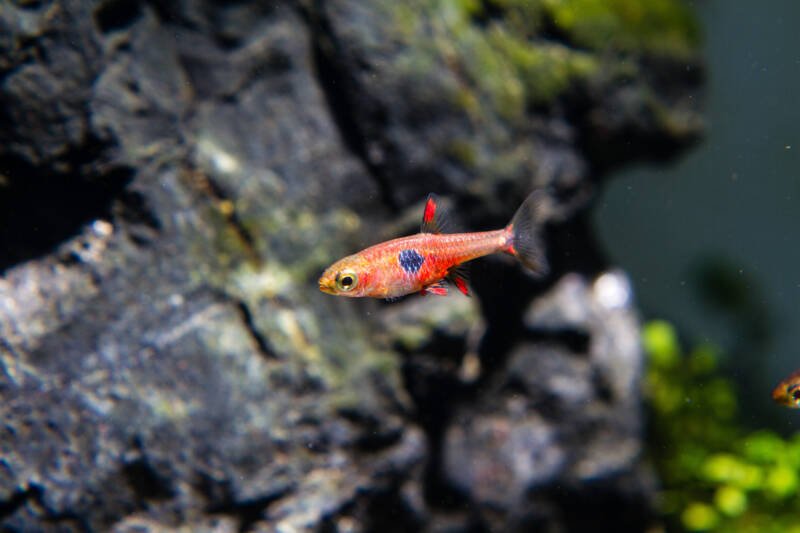
The Strawberry Rasbora is a small, peaceful fish from Asia. This orange fish prefers soft, acidic water and dim lighting. This species does well in a single-species tank or with other small, community-tank fish. Often confused with the dwarf rasbora, but the key distinction is only one spot on the body, and no additional spots on the tail.
Plant their aquarium for plenty of hiding places, and add driftwood to emulate their habitat. Keep water filtrated, but slow moving.
When keeping them in a small tank, stick to a small shoal of 6-8 fish, and pair them with Neocardina shrimp. These fish are delicate, and the water quality must be well-maintained. These fish are uncommon as they don’t tolerate changes in water chemistry.
- Number: 6
- Size: 0.7 inches
- Difficulty: Intermediate
- Temperament: Peaceful
- Diet: Omnivorous—flakes, pellets, freeze dried food (micro size)
- Temperature: 77-82.4°F
4. Ember Tetra (Hyphessobrycon amandae)
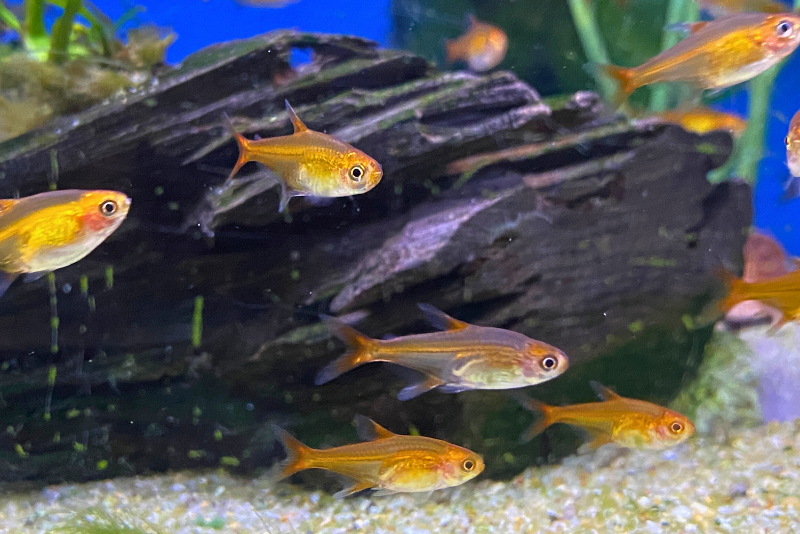
Ember tetras are among the few tetra species that can be kept in a 5-gallon tank. Other tetra species, even if small, need far more space as they are very active. Ember tetras are tiny, peaceful fish and should not be kept with predatory fish. So in a 5-gallon tank keep them as a solo species.
These bright orange-red South American fish need excellent, stable water conditions and well-planted tanks. Excellent plant species to use in your tetra tank are Java Moss, Ancharis, and Hornwort. Plants will also help keep your nitrate levels in your tank steady. Ember tetras are a little more sensitive to the hardness (mineral content) of the water and prefer softer water. You might find it helpful to do the water additions with Distilled water.
- Number: 6
- Size: 0.4-0.8 inches
- Difficulty: Beginner-Intermediate
- Temperament: Peaceful
- Diet: Carnivorous—flakes, pellets, freeze dried food (micro size)
- Temperature: 75.2-82.4°F
5. Celestial Pearl Danio (Danio margaritatus)(Previously Galaxy Rasbora)
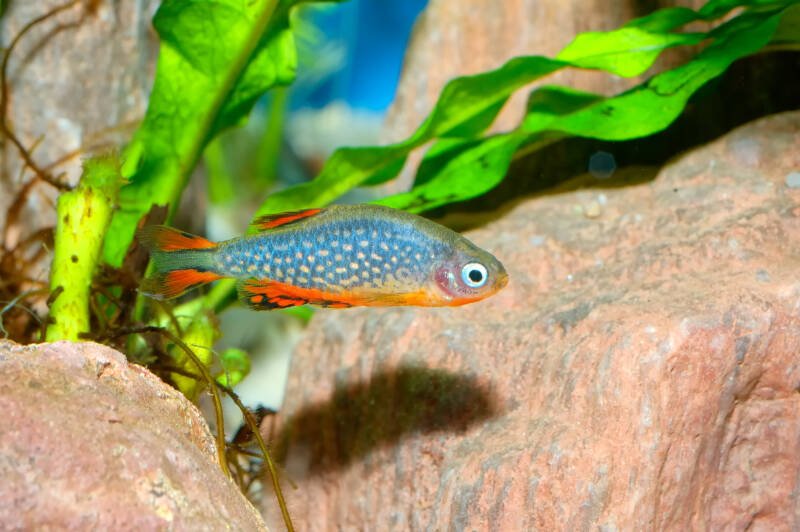
These stunning tropical fish from Myanmar should be kept in a single-species tank and will do well if kept in a well-planted environment. It’s preferable to keep them in a larger tank if possible, as males can get nippy toward each other.
These minute danios have a striking coloration of dark blue with small yellow spots and orange and black banded fins. Keep them in a small shoal in a well-planted aquarium with moderately hard, alkaline water.
- Number: 4
- Size: 0.8-1inches
- Difficulty: Intermediate
- Temperament: Peaceful, can get aggressive if there are too many males
- Diet: Omnivorous—prefers live food, can take pellets and flakes
- Temperature: 75.2-78.8°F
6. Guppy (Poecilia reticulata)
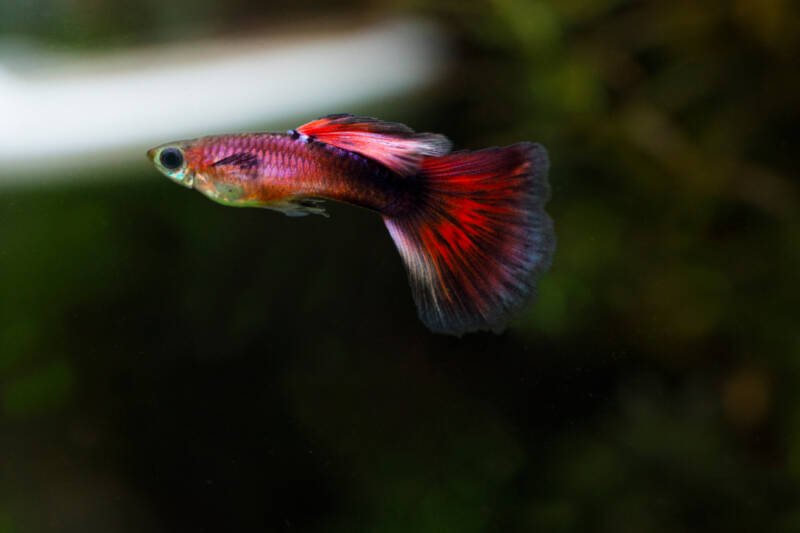
This easily recognizable and delightful fish has captivated fishkeepers since the start of the hobby. These livebearers are very easy to keep, colorful, and will breed quickly. For this reason alone, we recommend keeping only 2-3 males in a small tank; otherwise, you’ll be soon overrun with fry.
Of course, you can also keep them to breed for food for other predatory species. Originally from South America, they prefer lots of plant cover and a stable pH of 7; they are very hardy and can tolerate varied water types.
- Number: 3 males
- Size: 2-2.5 inches
- Difficulty: Beginner
- Temperament: Peaceful
- Diet: Omnivorous—pellets, flakes, live food
- Temperature: 68-82°F
7. Endler’s Live Bearer (Poecilia wingei)

Closely related to the guppy, the Endler is another live-bearing small fish with brightly colored bodies. They are peaceful fish and can be kept with other small peaceful tankmates. Their small size makes them unsuitable for tanks with predatory fish.
Endler’s Live Bearer is a very easy fish to keep and will breed readily, so again, keep sexes separated unless you plan to use the fry. These gorgeous fish prefer hard water and a well-planted tank to mimic their natural habitat. While they can be kept in small tanks, it’s recommended to go for a 20-gallon tank.
- Number: 3-4 males
- Size: 1.2-2 inches
- Difficulty: Beginner
- Temperament: Peaceful
- Diet: Omnivorous—pellets, flakes, live food
- Temperature: 68-82°F
8. Scarlet Badis (Dario Dario)
Scarlet Badis are tropical freshwater fish from India that must be kept in a specialist tank. They are colorful micro predators that can be aggressive towards other fish. They must be fed live foods such as baby brine shrimp and daphnia, though they can occasionally take pellets or flakes.
They are sensitive to water levels and must be kept in a well-maintained tank planted to give them plenty of hiding areas. Floating plants are also recommended. Males can be highly aggressive to other males, so they are best kept as a pair in a small tank.
Scarlet Badis can be timid and prefer soft sandy substrate and low light.
- Number: 1 male, 1 female
- Size: 0.8-1.2 inches
- Difficulty: Intermediate
- Temperament: Semi-aggressive
- Diet: Carnivorous—live food, frozen food
- Temperature: 72-78°F
9. Forktail Blue-Eye/Furcata Rainbowfish (Pseudomugil furcatus)
 The Forktail Rainbowfish hails from Indonesia and is a peaceful, happy-go-lucky fish that does well with other small, non-aggressive community fish.
The Forktail Rainbowfish hails from Indonesia and is a peaceful, happy-go-lucky fish that does well with other small, non-aggressive community fish.
These fish are so stinking cute! The males are the brightest in color. With yellow down the large wavy fins and brilliant blue eyes. The most notable feature of these fish is their dorsal fins sit higher up on their body making the mannerisms even more enjoyable.
They are active schooling fish and will do better when kept in a 10-gallon tank, however if you keep only 2 individuals of single sex they will do just fine in 5 gallons.
Keep them in thickly-planted tanks with floating plants and a lid, as they tend to jump. Keep the water well-oxygenated, but the flow gentle to mimic slow rainforest streams.
These fish are big eaters, and will always greet you at the glass to remind you of this. Be mindful to not overfeed, but monitor closely to ensure you are not underfeeding as well.
- Number: 2 females or 2 males
- Size: 2-2.4 inches
- Difficulty: Intermediate
- Temperament: Peaceful
- Diet: Omnivorous—live/freeze dried food, pellet, flake
- Temperature: 75.2-80.6°F
10. Betta (Betta splendens)
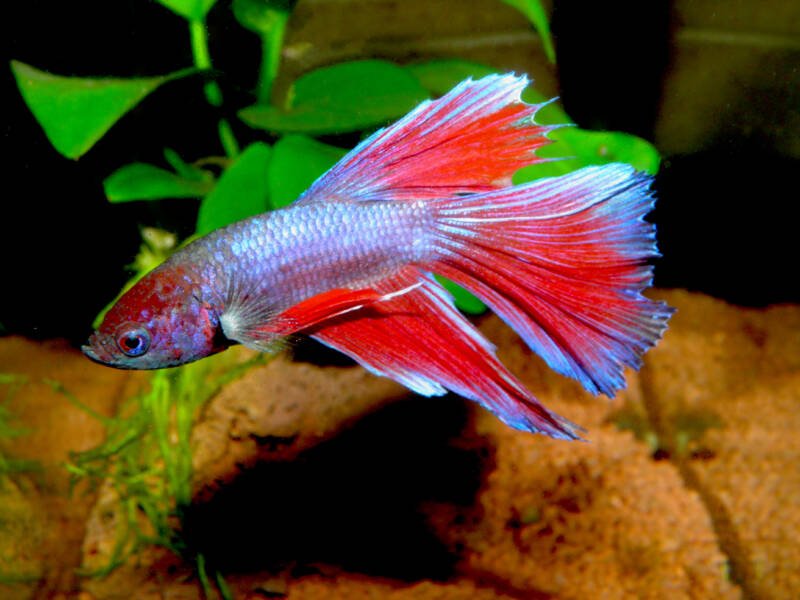
The dramatic Betta fish is common in many fish shops and is ideally suited to life in a small, single fish tank. However, they are often kept in substandard conditions, so be aware that they are tropical fish that need a heated, filtrated tank.
Betta fish are best kept alone in a tank, as they are territorial and will fight other male and female Bettas. They are also likely to be aggressive towards other long-finned fish. Mystery snails make good tank companions.
Keep their habitat natural with substrate, plants, and submerged branches. Use a sponge filter with a low rate to maintain water cleanliness. They will need air space at the top of the tank and a lid to prevent jumping.
- Number: 1
- Size: 2-3 inches
- Difficulty: Beginner
- Temperament: Peaceful with some fish, aggressive with males, cichlids, and long-finned fish.
- Diet: Carnivorous—live food, pellet, flake
- Temperature: 75-82°F
11. Dwarf Pea Puffer (Carinotetraodon travancoricus)
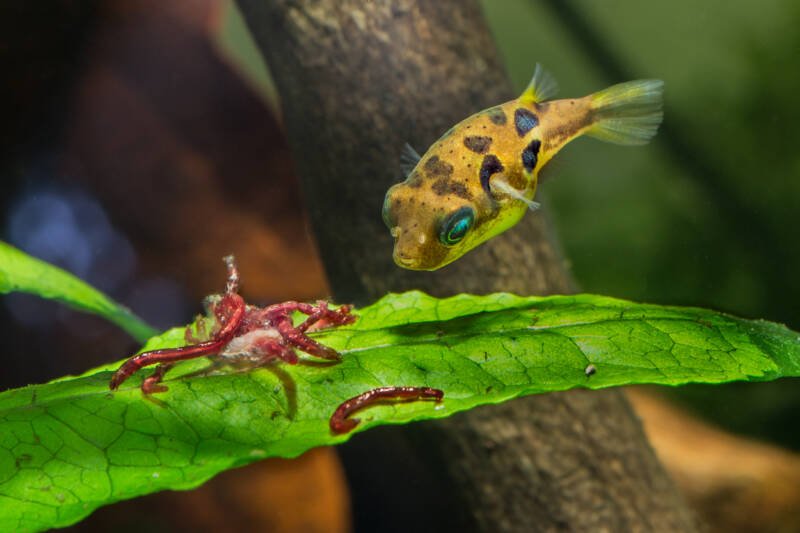
These adorable, golden fish come from South West India and prefer a heavily planted tank. An aquascaped tank is a must, they like to have places to hide, and using a lot of healthy live aquatic plants in your 5-gallon tank is advised, with wood and stones help mimic their environment.
Puffers are best kept in a single-species tank that is under 30 gallons They are known to be territorial and aggressive, eating tiny snails and sometimes showing aggression to other fish. This reputation can be a little misleading, and it is often the result of incorrect fishkeeping and not to be blamed on the pea puffer species as a whole.
In a larger tank this behavior lessens significantly, but in a 5 gallon tank you will more than likely see aggression towards other fish species. The pea puffer experts recommend 2.5 gallons per puffer – so a 5 gallon tank is at the max for 2 puffers. And those 2 puffers need to be monitored closely to ensure their compatibility. No two puffer personalities are alike!
Many pea puffers are wild caught and need to be de-wormed prior to introduction to your aquarium. This is a valuable question to ask from the pet store or online source you plan to buy your puffers from. If their abdomen is sunken in, this is a common sign they do have internal parasites, so seek advise and the proper medication for your new addition.
One key thing to note is pea puffers are carnivorous. They MUST have a varied, high protein carnivore diet – a vegetarian fed pea puffer will die. They love small snails, so this food source will need to be bred and offered regularly along with freeze dried, frozen and other live foods such as daphnia.
They are very rewarding fish, as they are active and provide hours of entertainment.
- Number: 1 -2
- Size: 1-1.5 inches
- Difficulty: Intermediate
- Temperament: Aggressive, territorial
- Diet: Carnivorous—live food, frozen, freeze dried, snails
- Temperature: 75.2-78.8°F
12. Least Killifish (Heterandria Formosa)
The Least Killifis, also known as the Midget Livebearer, is a tiny fish from the southeastern United States which are extremely easy to keep. They like to have densely planted tanks with a very gentle current to mimic their natural habitat.
Although tropical, they prefer cooler water than most other tropical fish. These tiny fish are pretty hardy and are rarely picky eaters. They do best in a single-species tank.
These olive-colored livebearers should be kept in small shoals with about 2 females to every male—they will breed quickly, so keep that in mind. They are best not kept with shrimp, as the fish may attack and eat them.
- Number: 3-5
- Size: 0.8-1.2 inches
- Difficulty: Beginner
- Temperament: Peaceful
- Diet: Carnivorous— pellet, flake, live food
- Temperature: 60.9-72.5°F
13. Bluefin Notho (Nothobranchius rachovii)
A Bluefin Nothos is a challenging African tropical fish with stunning vivid orange and blue coloration. They are better for advanced fishkeepers as their tank parameters must be exact for them to thrive.
They are best kept in a densely-planted mature tank with bogwood and dark substrate similar to the floodplains they come from.
Bluefin Nothos should have floating plants to dim the light entering the tank and a fitted lid to ensure these active fish cannot leap out. They prefer soft, slightly acidic water and should be kept in a single-species tank with gentle water movement and good filtration.
- Number: 1 male, 2 females
- Size: 1.5-2 inches
- Difficulty: Advanced
- Temperament: Aggressive
- Diet: Carnivorous—live food, frozen
- Temperature: 68-75°F
14. Bumblebee Goby (Brachygobius xanthozonus)
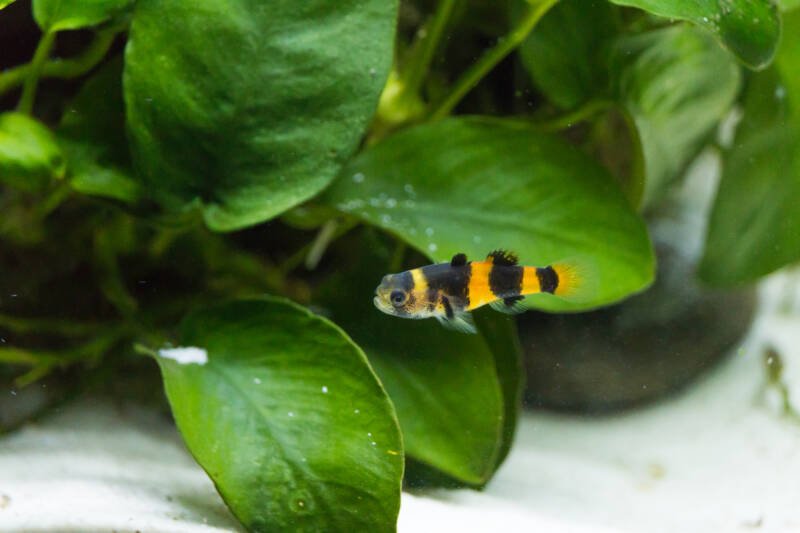 The Bumblebee Goby is a cute, musted-colored fish with dark stripes that is perfect for a small tank. However, despite their appealing looks, they are not easy fish to keep and are best suited to experienced hobbyists.
The Bumblebee Goby is a cute, musted-colored fish with dark stripes that is perfect for a small tank. However, despite their appealing looks, they are not easy fish to keep and are best suited to experienced hobbyists.
Originally from Asia, there is some confusion about whether they are freshwater or brackish fish. Though they can survive in brackish tanks, they prefer freshwater. They prefer tanks with gentle currents decorated with rocks and caves, soft sandy substrate, and added bogwood.
The water should be hard, and the best tank is a single-species tank, as they are prone to aggression. Some people have success keeping them in brackish community tanks, however. They can be territorial, especially if you have too many males in a small tank.
- Number: 1 male or 2 females
- Size: 1.2-1.4 inches
- Difficulty: Advanced
- Temperament: Aggressive
- Diet: Carnivorous—live food, ignore commercial fish foods
- Temperature: 73.4-82.4°F
15. Honey Gourami (Colisa chuna)
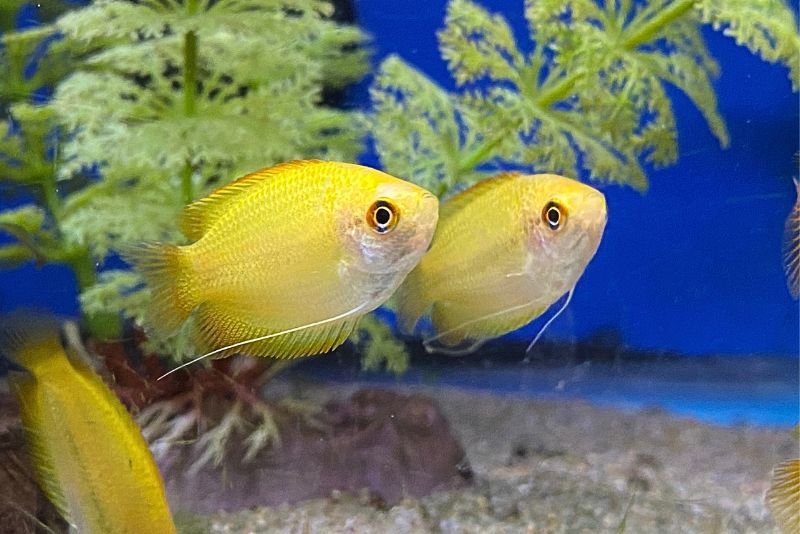
Honey Gourami are peaceful fish that do well when kept with a pair of females to every male. They are easy to keep but prefer space and hiding places. The males are an ochre color in the wild, but captive-bred varieties can be more vibrant gold and orange.
You may notice your honey gouramis will go to the surface and gulp. Like Betta fish, they have an organ called a labyrinth, allowing them to breathe air. These dwarf gouramis prefer to hang out in the lower part of the tank.
The tank will need a sound filtration system and slightly acidic water. You can provide the ideal aquarium by planting the tank thickly and allowing a clear middle space. Use floating plants for extra cover and for encouraging bubble nests. Snails make excellent tank companions.
- Number: 1
- Size: 2-2.8 inches
- Difficulty: Beginner
- Temperament: Peaceful, but can be aggressive during breeding
- Diet: Omnivorous—live food, pellet, flake
- Temperature: 72-78°F
16. Asian Stone Catfish (Hara jedoni)
The Asian Stone Catfish is a remarkable small fish from hill streams in Bangladesh and India. It prefers slow-moving water. Provide a sandy substrate and many plants, rocks, and driftwood for cover.
Although it’s a micro-predator, it’s a peaceful little fish that gets on well with other fish the same size. These catfish do best when kept in large groups of their own kind and, ideally, the largest group you can possibly keep, so a big tank is preferable.
They prefer to feed on live or frozen food and may be reluctant to eat pellets or flakes. They are most active and like to feed at night, so provide the tank with bright lighting during the day to ensure a nocturnal mode.
They can be difficult to source and can be a challenging species to keep for beginners. However, once you can get their feeding right and your tank is well-filtered and kept clean, they are an easy species to maintain. They can be kept with adult dwarf shrimp in nano tanks.
- Number: 3-4
- Size: 1-1.2 inches
- Difficulty: Advanced
- Temperament: Peaceful
- Diet: Carnivorous—live food, frozen
- Temperature: 68-75°F
17. Cherry Shrimp (Neocaridina heteropoda)
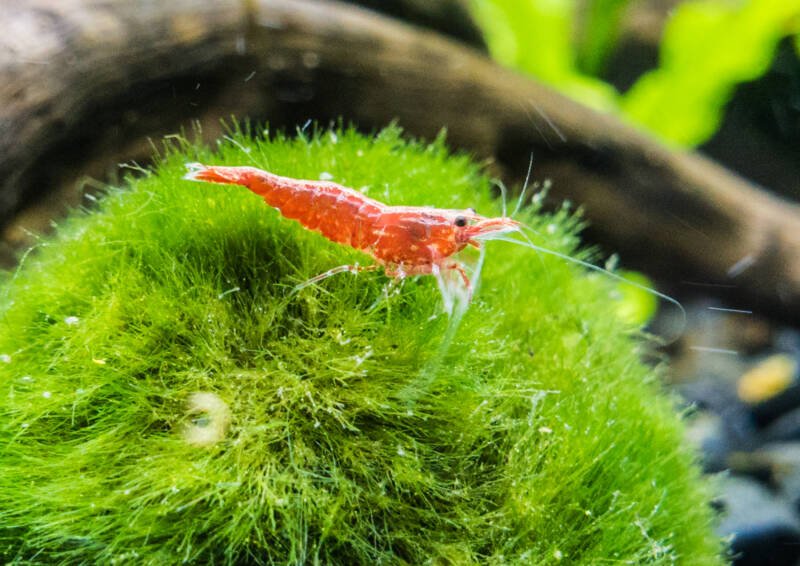
Cherry Shrimp from Taiwan make excellent inhabitants for small tanks and are often a good choice for keeping with other small fish as they usually stick to the bottom. Females are larger and have a deep red color, while the smaller males are a little more translucent.
Shrimp are also a fantastic way to combat tank algae, as they readily eat algae and other organic matter. These curious little critters prefer tanks that are heavily planted, as they like to be able to hide from predators.
Every month or so, the shrimp will hide away to molt, so don’t be alarmed if your shrimp have mysteriously disappeared. If you’re concerned about keeping fish in a small tank, cherry shrimp are the perfect alternative.
You can keep around 10-25 cherry shrimp in a 5-gallon tank, as they have a very low bioload. When keeping with other fish, a smaller number is better.
- Number: 10-25
- Size: 0.5-1 inches
- Difficulty: Beginner
- Temperament: Peaceful, might be eaten by larger fish
- Diet: Omnivorous—shrimp pellets, algae wafers, vegetables
- Temperature: 71.6-82.4°F
18. Amano Shrimp (Caridina multidentata)
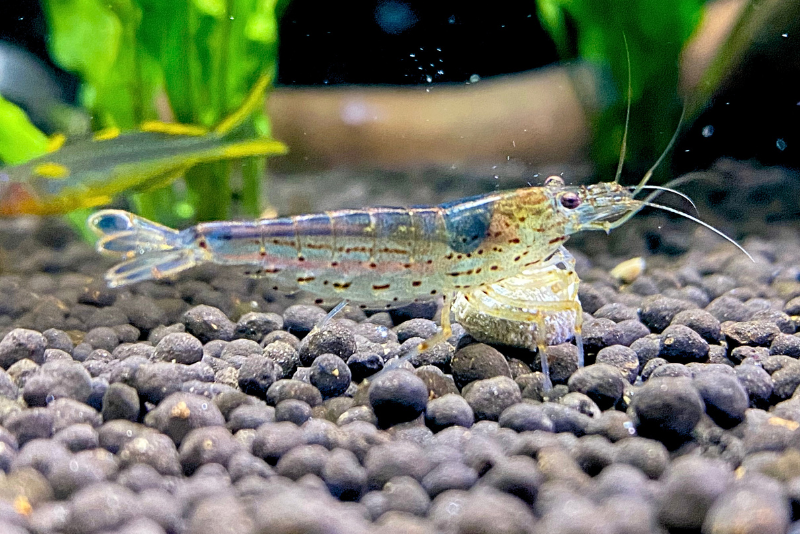
Amano Shrimp are another small freshwater shrimp species from Japan. They do very well in planted aquariums and will consume algae, including some of the more troublesome varieties, which makes them a fantastic addition to almost any tank.
These peaceful little shrimp are bigger than the Cherry Shrimp and translucent green with black spots. Unlike the Cherry Shrimp, they will not breed as they need salt water to reproduce. This can make them a better choice if you worry about overpopulating your tank.
They are easy to keep and compatible with many other fish, and their foraging feeding habits make them excellent at helping keep your tank clean. However, they will be eaten by larger fish. When molting, they hide away until their new shell hardens.
- Number: 5
- Size: 1.5-2 inches
- Difficulty: Beginner
- Temperament: Peaceful, might be eaten by larger fish
- Diet: Omnivorous—shrimp pellets, algae wafers, vegetables
- Temperature: 64-81°F
19. Ghost Shrimp (Palaemonetes paludosus)
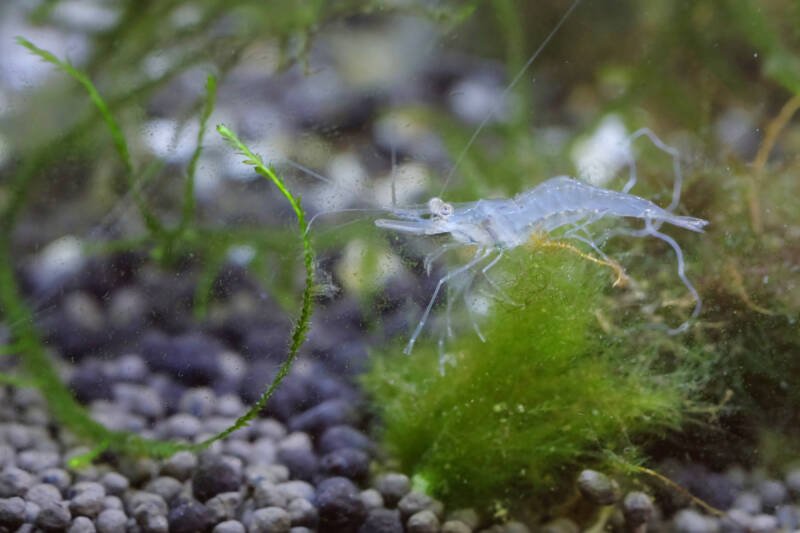
Also known as Ivory Shrimp and Glass Shrimp, these see-through freshwater shrimp are easy to keep but should not be housed with other shrimp species. You should also avoid keeping them with large or predatory fish as they will quickly become a snack.
They are larger than Cherry or Amano shrimp and will eat smaller shrimp, fry, and algae. They like to burrow to feed, and they are easier to see if you use a black substrate in your aquarium. Like other shrimp, they will hide away to molt.
Ghost Shrimp are cheap, easy to source, and are peaceful tank inhabitants. They do well kept with snails and fish of a similar size. They are generally hardy and will do well in a small tank, provided the water parameters are maintained and they have plants and other hiding places.
- Number: 3-4
- Size: 2-3 inches
- Difficulty: Beginner
- Temperament: Peaceful, might be eaten by larger fish
- Diet: Omnivorous—shrimp pellets, algae wafers, vegetables
- Temperature: 68-84.2°F
20. Nerite Snail (Neritina natalenis sp)

Nerite Snails are fantastic additions to a small tank. They are freshwater snails with lovely color variations and do a great job cleaning your tank. They like tanks that are well-oxygenated and have plenty of algae.
They like to eat algae, so they are unlikely to eat your tank plants, and since Nerites need brackish water for the newly hatched snails to survive, they will not over-run your tank. While your Nerite snail may lay eggs, these are unlikely to hatch.
They will spend their time slowly exploring the tank, constantly grazing on algae, so they may starve if your tank has no algae. In this case, you must supplement their diet with algae wafers.
They are sometimes known as Mystery Snails and are popular for being colorful, peaceful, and eating algae. You’ll need a tight lid on your tank to prevent your Nerite Snail from wandering off.
- Number: 3
- Size: 0.5-1.25 inches
- Difficulty: Beginner
- Temperament: Peaceful; avoid keeping with large, aggressive fish
- Diet: Herbivore—algae, algae wafers, blanched vegetables
- Temperature: 64.4-82.4°F
21. Malaysian Trumpet Snail (Melanoides tuberculate)

Malaysian Trumpet Snails are horn-shaped snails that like to burrow into the substrate as they scavenge. This makes them excellent at reducing pockets of anaerobic bacteria that could affect your tank water quality.
They are excellent tank mates for almost any other fish, barring predatory species. They will move slowly about the tank, under the substrate, eating organic debris. They tend to breed rapidly, so keep an eye on them to prevent overpopulation.
Some hobbyists consider them pests as they often hitchhike into tanks via new plants.
- Number: 2
- Size: 0.5-1 inches
- Difficulty: Beginner
- Temperament: Peaceful; avoid keeping with large, aggressive fish
- Diet: Herbivore—pellet food, flake, algae
- Temperature: 64.4-86°F
22. Dwarf Mexican Crayfish (Camberellus patzcuarensis)
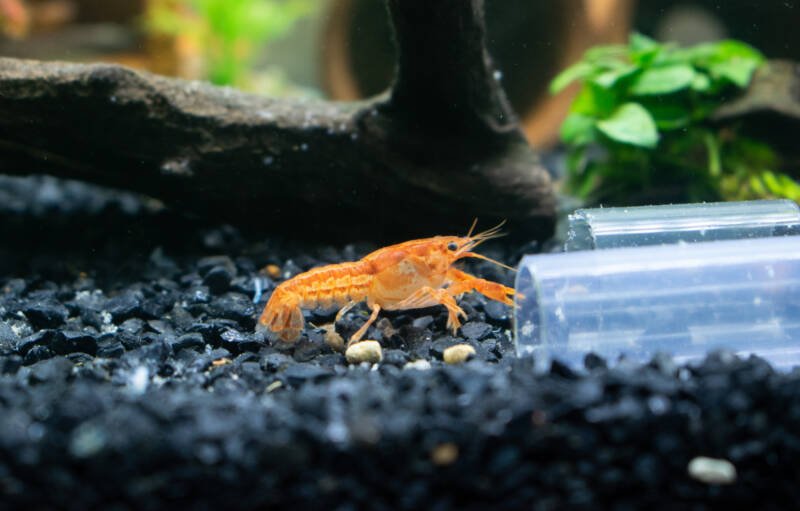 If you’re looking for something slightly more unusual for your tank, consider keeping one of the two species of dwarf crayfish. The Mexican Dwarf Crayfish is a peaceful freshwater lake crayfish and a good addition to community tanks.
If you’re looking for something slightly more unusual for your tank, consider keeping one of the two species of dwarf crayfish. The Mexican Dwarf Crayfish is a peaceful freshwater lake crayfish and a good addition to community tanks.
These crayfish need a tank with hiding places to molt safely and avoid keeping them with predatory fish. A good tank will have caves, logs, driftwood for hiding, and a HOB (hang on back) filter to maintain high water quality.
While wild varieties are brown or olive, new orange variants have been developed, popular with fish keepers.
- Number: 2
- Size: 1.5-2 inches
- Difficulty: Intermediate
- Temperament: Peaceful; avoid keeping with predatory fish
- Diet: Omnivore—live food, scavenger
- Temperature: 71.6-75.2°F
23. Thai Micro Crab (Limnopilos naiyanteri)
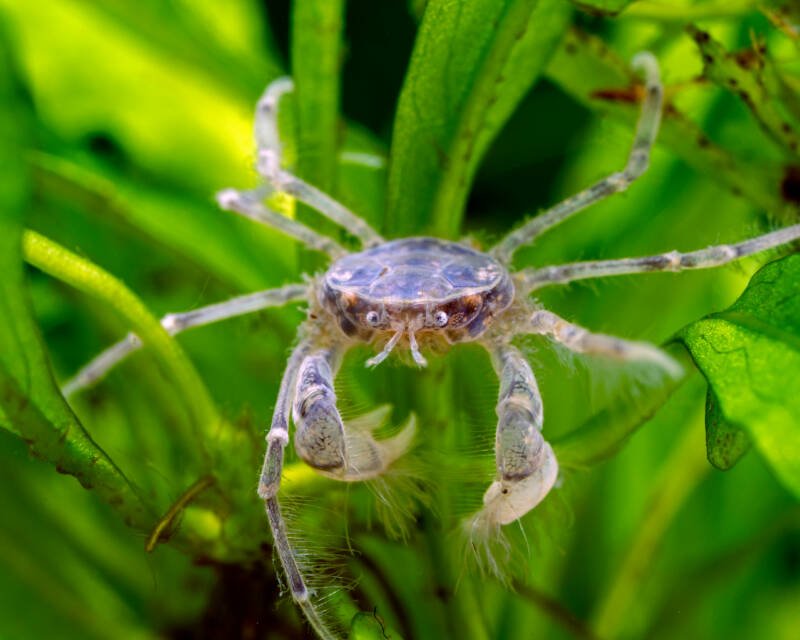 The Thai Micro Crab is a minute freshwater crab species that should be kept in a single-species tank to avoid being eaten. It’s possible to keep it with Micro Rasboras, Ember Tetras, or Cherry Shrimp, but they will like a heavily planted tank with lots of hiding places.
The Thai Micro Crab is a minute freshwater crab species that should be kept in a single-species tank to avoid being eaten. It’s possible to keep it with Micro Rasboras, Ember Tetras, or Cherry Shrimp, but they will like a heavily planted tank with lots of hiding places.
These little light gray crabs are peaceful and shy, and can sometimes be found hiding in the roots of floating plants, so consider adding some hornwort and duckweed. They eat algae and organic debris and prefer neutral to slightly soft, acidic water.
- Number: 5
- Size: 0.3-0.4 inches
- Difficulty: Intermediate
- Temperament: Peaceful; avoid keeping with predatory fish
- Diet: Omnivore—pellets, algae, scavenger
- Temperature: 71.6-75.2°F
FAQ’s
Q: Can I keep a betta fish in a 5 gallon tank?
A: Yes, a 5 gallon tank can be suitable for a betta fish. Betta fish are known for their ability to breathe air from the surface, which allows them to tolerate smaller tanks. However, it is important to provide proper filtration and maintain good water quality.
Q: What should I consider when choosing fish for a 5 gallon tank?
A: When selecting fish for a 5 gallon tank, consider their size, activity level, and compatibility. Choose small fish species that do not require a lot of swimming space. Avoid aggressive fish that may harass tank mates in such a confined environment.
Q: How often should I clean a 5 gallon fish tank?
A: Regular maintenance is crucial for the health of the fish and the overall water quality in a 5 gallon tank. Perform a partial water change of about 25% every week and clean the tank, including removing debris and algae, on a regular basis.
Q: Can I use live plants in a 5 gallon tank?
A: Yes, live plants can be beneficial for a 5 gallon tank. They help to oxygenate the water, provide hiding spots for the fish, and absorb excess nutrients. However, choose plants that are suitable for the tank size and lighting conditions.
Q: What equipment do I need for a 5 gallon fish tank?
A: For a 5 gallon fish tank, you will need a suitable filter to maintain water quality, a heater (if necessary for the fish species you choose), a thermometer to monitor water temperature, a lighting system (if using live plants), and basic aquarium maintenance supplies such as a net, gravel vacuum, and water conditioner.
Q: What are the best lights for a 5 gallon tank?
A: The lighting requirements for a 5 gallon tank will depend on the type of plants and fish you have. If you have live plants in your tank, it’s important to provide them with adequate lighting for photosynthesis. Here are some options for lighting a 5 gallon tank:
- LED Lights: LED lights are a popular choice for aquariums due to their energy efficiency, long lifespan, and versatility. Look for LED lights specifically designed for small tanks or nano tanks, as they will provide appropriate light intensity and spectrum for your 5 gallon setup. LED lights are often a small bar light that spans the width of the tank.
- Clip-On Lights: Clip-on lights are a convenient option for smaller tanks. These lights can be attached to the edge of the tank and directed towards the water surface, providing ample lighting for your fish and plants. Make sure to choose a clip-on light that fits securely and has adjustable positioning. Many clip-on-lights are also LEDs, our favorite is the Fluval Planted Nano